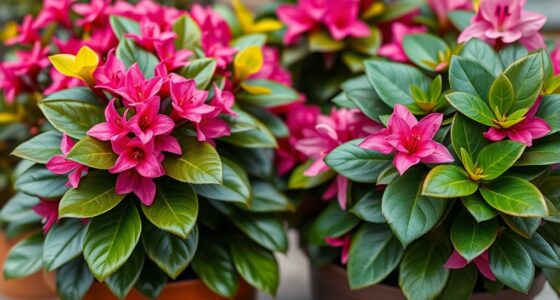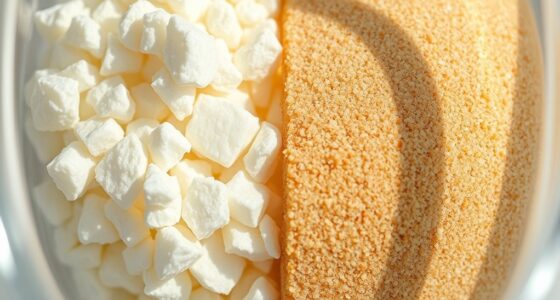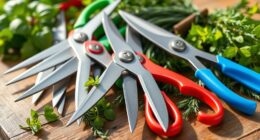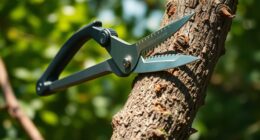Seabird guano offers a balanced mix of nutrients, including phosphorus and minerals, making it ideal for overall plant growth. In contrast, bat guano has higher nitrogen and potassium levels, which benefit leafy plants and controlled environments. Environmental impact and harvesting methods differ, with seabird guano having a larger footprint. Choosing the right fertilizer depends on your garden’s needs and sustainability goals. To discover which fits your gardening style best, explore the details below.
Key Takeaways
- Seabird guano offers a balanced mineral profile with broader nutrients, while bat guano is higher in nitrogen and potassium.
- Seabird guano is more sustainable but often more expensive and less available; bat guano is typically more accessible and cost-effective.
- Both enhance soil fertility, but seabird guano supports overall plant health with diverse minerals; bat guano primarily boosts nitrogen levels.
- Proper harvesting and storage are essential to manage odor and environmental impact for both types.
- The choice depends on specific plant needs, budget, and sustainability priorities.
Composition and Nutrient Content

Seabird guano and bat guano differ markedly in their composition and nutrient content, which impacts their effectiveness as fertilizers. Seabird guano is rich in minerals like phosphorus and nitrogen, often derived from organic sources that have accumulated over long periods. It typically contains a balanced mineral content, making it highly effective for promoting plant growth. Bat guano, on the other hand, tends to have a higher nitrogen concentration and a different mineral profile, with notable amounts of potassium. Its organic sources come from insects and other organic debris in caves, leading to a distinct nutrient composition. These differences influence how each type of guano feeds your plants, with seabird guano providing a broader mineral spectrum, and bat guano offering a more nitrogen-focused boost. Additionally, the mineral and nutrient levels in both guanos are affected by their source environment, which plays a crucial role in their overall profile and fertilizing properties. Environmental factors can also impact the nutrient density, further shaping their fertilization potential. Furthermore, the organic material in each guano type contributes to their unique mineral profiles and nutrient availability, affecting their suitability for different plant needs.
Source and Harvesting Methods

The origins and collection methods of seabird and bat guano substantially influence their nutrient profiles and availability. Seabird guano is typically harvested from colonies on remote islands, where harvesting rituals ensure minimal disturbance and preserve source authenticity. In contrast, bat guano is gathered from caves or roosting sites, often through manual scooping or specialized equipment. These methods impact nutrient quality and environmental sustainability. The harvesting practices employed can also affect the long-term viability of the sources. Additionally, environmental factors such as climate conditions can influence the nutrient composition and abundance of both types of guano.
Nutritional Benefits for Plants
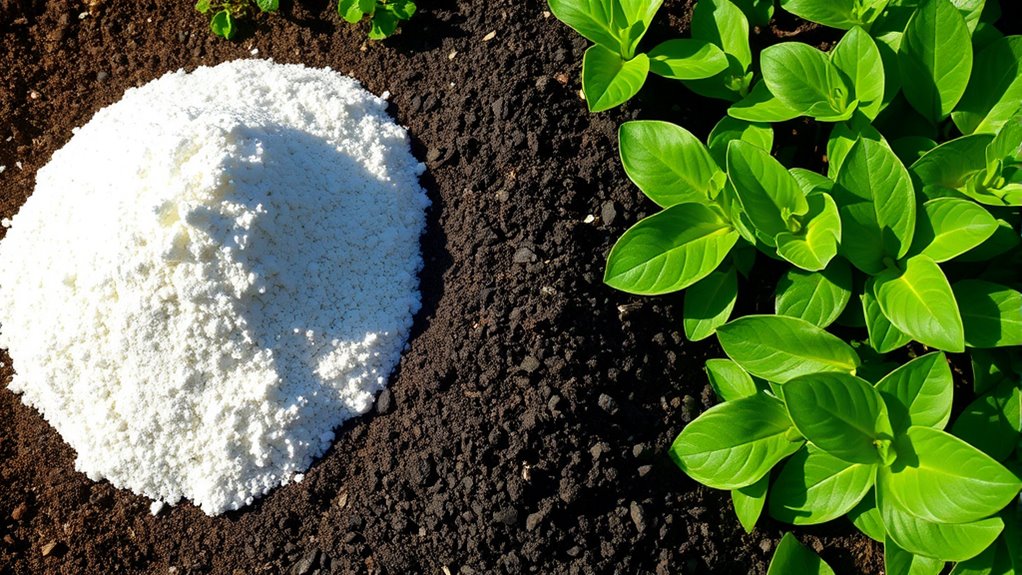
Both seabird and bat guano are highly valued fertilizers because they supply essential nutrients that promote healthy plant growth. These nutrients include high levels of nitrogen, phosphorus, and potassium, which are crucial for robust plant development. Nitrogen boosts leafy growth, phosphorus encourages strong root systems and flowering, and potassium improves overall plant health and disease resistance. When you incorporate guano into your soil, you enhance soil health by enriching it with organic matter and beneficial minerals. This creates a nutrient-rich environment that supports consistent plant growth over time. Both types of guano help improve nutrient availability, ensuring your plants receive what they need for ideal development. Additionally, guano is a plant-based source of nutrients that can help reduce reliance on synthetic fertilizers, leading to more sustainable gardening practices. Ultimately, using either guano can lead to healthier, more vigorous plants and richer yields.
Environmental Impact and Sustainability

While guano fertilizers are effective for boosting plant growth, their environmental impacts and sustainability vary considerably. Seabird guano often has a larger ecological footprint due to overharvesting and habitat disruption, whereas bat guano can be sourced more sustainably if harvested responsibly. Choosing sustainable sourcing methods reduces harm to ecosystems and ensures long-term availability. Consider this comparison:
| Aspect | Seabird Guano | Bat Guano |
|---|---|---|
| Ecological Footprint | Higher, due to overharvesting | Lower, with responsible harvesting |
| Habitat Impact | Disrupts seabird colonies | Minimal if harvested sustainably |
| Long-term Sustainability | Challenging without regulation | More sustainable with proper practices |
Being mindful of these factors helps minimize environmental impact while supporting eco-friendly agriculture. Additionally, adopting sustainable harvesting practices is crucial to mitigate these issues and promote conservation.
Application Techniques and Usage
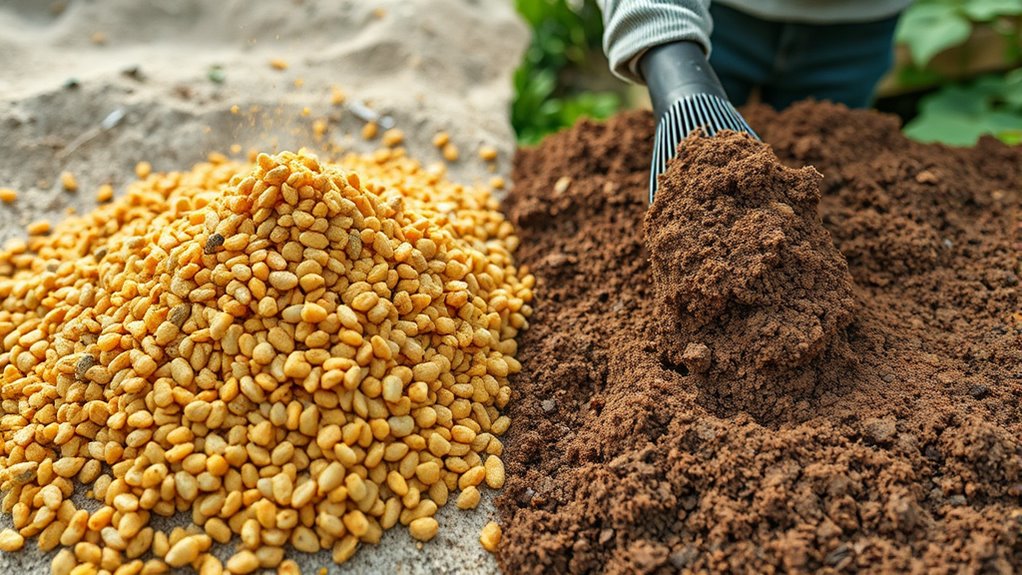
Proper application techniques are essential to maximize the benefits of guano fertilizers and minimize waste or environmental impact. You should carefully consider application timing—applying when plants need nutrients most, such as early growth or flowering stages. This ensures nutrients are absorbed efficiently. When it comes to application methods, sprinkle or lightly dig the guano into the soil around your plants, avoiding direct contact with leaves to prevent damage. Use the appropriate amount based on your crop type and soil condition, as over-application can lead to runoff or nutrient imbalance. For best results, water the area after applying, which helps the nutrients penetrate the soil. Additionally, understanding the filter maintenance and how they interact with different surfaces can help you customize your gardening tools or labels for better organization. Employing proper application techniques not only boosts plant health and enhances yields but also helps prevent environmental concerns by reducing excess runoff. Consistently following proper application techniques improves plant health, enhances yields, and reduces environmental concerns.
Odor and Storage Considerations
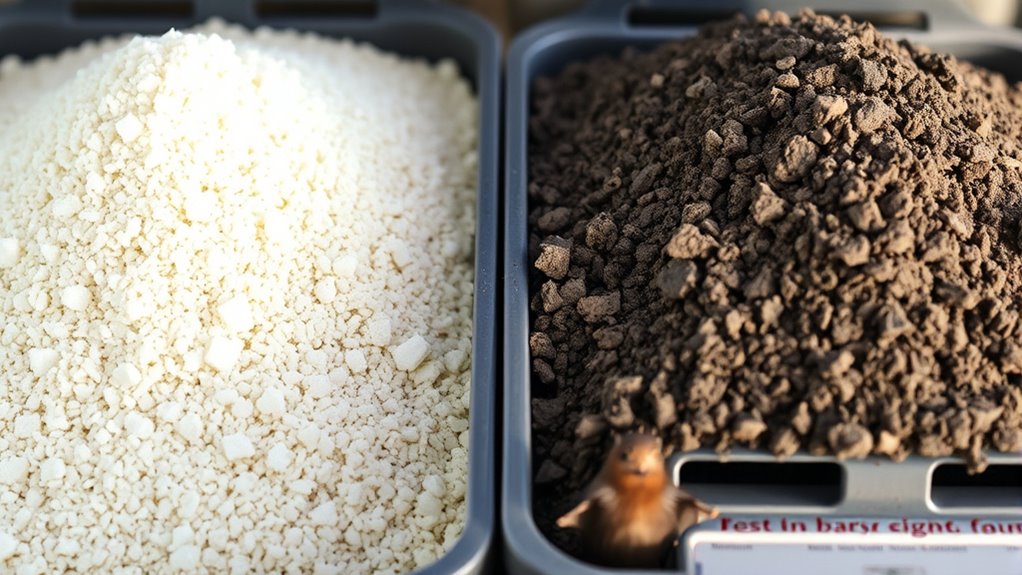
You’ll notice that both guano types can produce strong odors, which might affect your storage space and overall environment. Handling and storing them properly is essential to prevent unpleasant smells and potential health issues. Understanding these odor levels and challenges will help you choose the best option for your needs. Proper storage containers and ventilation can significantly mitigate odor concerns, especially when dealing with best laundry detergents that emphasize odor control. Additionally, some storage solutions are designed specifically to contain and neutralize strong odors, making maintenance easier. Being aware of the odor and storage considerations can help you maintain a clean and healthy environment while using either type of guano.
Odor Levels and Impact
Odor levels are a key factor to contemplate when handling either seabird or bat guano, as both types can produce strong, sometimes unpleasant smells. These odors are caused by airborne particles released during application or movement, which can linger in your workspace. To minimize impact, consider odor masking techniques such as aeration or using odor-neutralizing agents. Seabird guano often has a sharper smell, while bat guano might be earthier but still potent. Proper ventilation is essential to prevent odors from building up and affecting your environment. You’ll want to handle and store these fertilizers in well-ventilated areas to reduce airborne particles and odor emissions. Managing odor levels effectively ensures safer, more comfortable handling and minimizes disruption to your surroundings. Additionally, understanding the odor levels associated with each type can help you choose the best storage and handling practices to suit your needs. Implementing ventilation strategies can significantly reduce odor buildup and improve safety during storage and application. Regularly monitoring air quality can also help detect odor issues early and maintain a healthier workspace.
Storage and Handling Challenges
Handling and storing seabird and bat guano present unique challenges, especially regarding odor control and storage safety. These fertilizers can emit strong smells, making proper packaging options essential to contain odors and prevent leaks. Additionally, storage longevity varies; guano must be kept in airtight containers to maintain quality and prevent spoilage. Improper storage can lead to unpleasant odors spreading and potential health hazards. Use durable, sealed containers designed for long-term storage to preserve nutrient integrity. Consider these factors:
| Packaging Options | Odor Control | Storage Longevity |
|---|---|---|
| Airtight barrels or bags | Seals out odor, prevents leaks | Extends shelf life |
| Heavy-duty plastic containers | Reduces smell escape | Maintains quality |
| Metal drums | Durable, odor-resistant | Ensures safety |
| Vacuum-sealed bags | Keeps odors contained | Prolongs freshness |
Cost and Availability

You’ll notice that seabird guano tends to be more expensive than bat guano, mainly due to regional supply chains and harvesting methods. Availability can also shift seasonally, making it harder to find at certain times of the year. Understanding these factors can help you choose the best option for your needs and budget. Additionally, sound synthesis techniques can be employed to craft more compelling narratives that communicate the unique benefits of each fertilizer type to your audience or customers.
Price Differences
While both seabird and bat guano are valued as natural fertilizers, their prices can vary considerably due to differences in availability and production costs. Pricing trends often reflect market fluctuations driven by supply and demand, affecting affordability. Seabird guano tends to be more expensive because of limited geographic sources and the labor-intensive collection process. In contrast, bat guano is generally more accessible but can still experience price spikes during high demand seasons. Factors influencing costs include transportation expenses, collection methods, and quality standards. Additionally, the efficiency of heat transfer in fertilizer processing can impact production costs and, consequently, the final pricing.
Regional Supply Chains
The supply chains for seabird and bat guano differ markedly, shaping their overall availability and cost. Seabird guano depends on remote islands where bird migration patterns concentrate colonies, making extraction costly and limited to specific regions. In contrast, bat guano is primarily sourced from caves within bat habitats, often closer to human populations, which can streamline transportation and reduce costs. Bird migration influences seabird guano supply, as seasonal migrations determine when colonies are accessible. Bat habitats, often in caves or abandoned mines, are more stable but limited in number, affecting supply consistency. These geographic factors directly impact the cost and availability of each fertilizer, with seabird guano often being more expensive due to logistical challenges, while bat guano benefits from more localized and steady sources.
Seasonal Availability
Seasonal fluctuations considerably influence the cost and availability of both seabird and bat guano. During peak seasons, the supply increases due to natural breeding and nesting cycles, making fertilizers more accessible and often cheaper. Off-season, limited collection leads to higher prices and scarcity, impacting your seasonal timing needs. Proper fertilizer storage becomes essential to preserve its quality during low availability periods.
- Seabird guano is more available after breeding seasons, typically in late summer or fall.
- Bat guano’s availability peaks when caves or roosts are actively colonized.
- Costs tend to rise during off-season months, requiring advance planning.
- Storage methods, like airtight containers, help maintain fertilizer quality during seasonal shortages.
Suitability for Different Garden Types

Choosing the right type of guano depends largely on your garden’s specific needs and soil conditions. Seabird guano enriches soil quickly, making it ideal for traditional gardens with nutrient deficiencies. Bat guano, with its balanced nitrogen and phosphorus, suits urban gardening setups and aquaponics compatibility, promoting healthy plant growth without overwhelming systems. Consider your garden type:
| Garden Type | Suitable Guano | Notes |
|---|---|---|
| Traditional Garden | Seabird guano | Fast-acting, boosts soil nutrients |
| Urban Gardening | Bat guano | Gentle, supports container plants |
| Aquaponics Systems | Bat guano | Maintains balance, safe for aquatic life |
| Vegetable Gardens | Both (based on needs) | Adjust application accordingly |
| Container Gardens | Bat guano | Easy to control, prevents over-fertilizing |
This table helps visualize which guano suits your garden, whether you’re optimizing for aquaponics or urban gardening.
Potential Drawbacks and Precautions
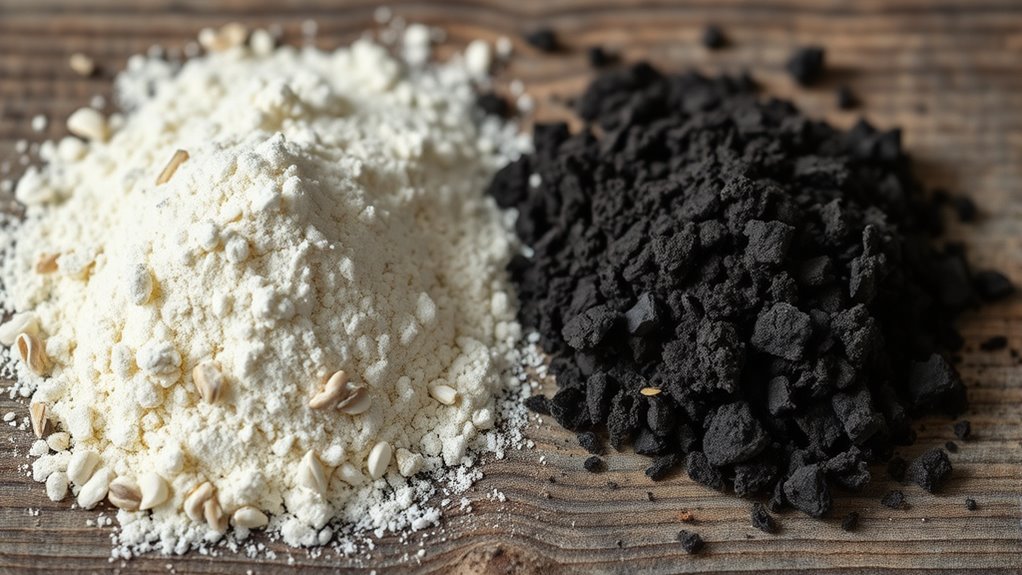
While guano can boost your garden’s growth, it also comes with potential drawbacks and precautions you should consider. One major concern is toxicity; excessive use can damage plants or harm nearby wildlife. You should also be aware of allergy risks, especially if you handle dry guano regularly, as it can trigger respiratory issues or skin irritation. Additionally, improper storage or application may lead to contamination or odor problems. There’s also the risk of introducing pests or pathogens if the guano isn’t properly processed. To stay safe, always wear gloves and masks when handling guano, and follow recommended application rates. Keep containers sealed and store guano away from children and pets to prevent accidental ingestion or contact.
Frequently Asked Questions
How Long Does Each Type of Guano Last as a Fertilizer?
You might wonder about the storage duration of each guano type as a fertilizer. Seabird guano typically lasts longer due to its slower decomposition rate, often providing nutrients for several months. Bat guano decomposes faster, usually lasting around one to three months. Proper storage in a cool, dry place helps maintain its effectiveness longer. Keep in mind that application frequency and soil conditions also influence how long each fertilizer benefits your plants.
Are There Any Legal Restrictions on Harvesting or Using Guano?
You need to be aware of regulations compliance and harvesting restrictions when using guano. Laws vary by region, and some areas have strict rules to protect wildlife and ecosystems, limiting how and when you can harvest. Make sure to research local regulations before collecting or applying guano. This helps you stay legal and sustainable, avoiding fines or environmental harm. Always prioritize responsible practices to support conservation efforts.
Can Guano Be Used on Organic Certification Standards?
Imagine nurturing your garden with nature’s purest gift—guano. Yes, it can meet organic standards if it’s processed properly and free from synthetic additives. To gain certification, you must guarantee it complies with certification requirements, including sourcing and processing standards. When used correctly, guano enhances soil naturally, aligning with organic principles. Always check your organic certifier’s guidelines to confirm it qualifies and supports your commitment to eco-friendly gardening.
How Do Weather Conditions Affect Guano’s Effectiveness?
Weather conditions critically impact guano’s effectiveness. High humidity can cause it to break down faster, reducing its nutrient content, while low humidity helps preserve its quality. Rainfall effects are vital; heavy rain can wash away nutrients, diluting the fertilizer and decreasing its efficiency. You should apply guano during dry periods or when rain is not forecasted, ensuring ideal absorption and nutrient retention for healthy plant growth.
Are There Any Common Pests Attracted to Guano-Amended Soils?
When using guano-amended soils, you should be aware of pest attraction, as pests like insects and rodents may be drawn to the nutrient-rich environment. This can lead to soil contamination if pests spread disease or damage plants. To prevent issues, keep the soil well-managed, avoid over-application, and monitor for pests regularly. Proper composting and storage also help minimize pest attraction and protect your garden’s health.
Conclusion
Choosing between seabird and bat guano is like selecting the right key for a lock—both open doors to healthy plants, but each has its unique tune. I once used bat guano in my garden, and within weeks, my tomatoes thrived like never before. Think of it as revealing your garden’s potential; understanding their differences helps you pick the perfect fertilizer. Ultimately, your choice depends on your garden’s needs and sustainability goals.


